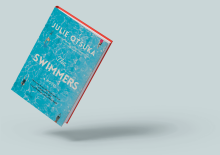Arts & Culture

Ten stories you won't find on a pre-recorded menu of options.

The question at the center of both the parable of the talents and Jerry & Marge Go Large is the same: What will you do with all you’ve been given?

The new series Prehistoric Planet offers a vision of Cretaceous life; a world filled with life completely different from our own, yet on this same planet. In a time when life is precarious and extinction all around, our prehistoric predecessors offer some comfort and not a little bit of escape.

Rahab’s story deserves to be remembered, as do many of the films we encounter that address the nuances, joys, and sorrows of the immigrant experience.

“I don’t think we talk enough about the delight in sexuality, especially spiritually,” Oladokun told Sojourners. They also take inspiration from the spirit of the Last Supper, comparing queer love to communion and noting “there’s something kind of romantic about Jesus at a candle-lit dinner with a bunch of his bros being like, ‘I am this bread. I am this wine. I am what you can feed off of in this moment.’”

Actually just 10. But that's five more than in Paul Simon’s famous song.

It feels as if there’s an incantation around Dance Fever. Florence Welch leads us through the complexities of finding beauty and purpose amid suffering and evil. The 14 tracks take us on a mythic journey that lingers on the pain.

LASCAUX IS FAMOUS for its Paleolithic cave paintings, found in an underground complex in southwest France. The biggest area of Lascaux with the most abundant paintings is an echo chamber. Enveloped in sound, our human ancestors may have drummed and danced around a flickering fire whose shadows animated the natural scenes of people, animals, and their environment on the surrounding walls—all inviting transcendence. In ancient Greek religion, the lyrical music of Orpheus charmed the gods and compelled animals, even rocks and trees, to dance. Early Christian iconography developed a practice of liturgical art that both offered theological instruction and included details of the plant and animal world, both literal and allegorical, to foster spiritual reverence.
Closer to our time, great thinkers such as 19th-century German explorer-scientist Alexander von Humbolt looked beyond isolated organisms to the unity among plants, climate, and geography. In the 20th century, French Jesuit and paleontologist Pierre Teilhard de Chardin’s perception that the universe is an evolutionary process moving toward greater complexity and consciousness furthered the understanding that humans are interdependent with the created world. Albert Einstein wrote that human beings experience ourselves “as something separate from the rest—a kind of optical delusion of consciousness” and that “we will have to learn to think in a new way” if humanity is to survive. This view is echoed in new developments in quantum physics that we may be evolving toward a more coherent wholeness among spirituality, science, and art.
The icon paintings of Angela Manno, an internationally exhibited and collected artist, are yet another expression of this lineage in her series “Sacred Icons of Endangered Species.” I interviewed Manno by email and telephone in March.
Andrea M. Couture: As a contemporary artist, what attracted you to icon painting, one of the oldest forms of Christian art, going back to the third century?
Angela Manno: I’ve been fascinated by non-Western and ancient art forms throughout my life, from illuminated manuscripts as a child to batik while traveling through Indonesia in my early 20s; icon materials—gold leaf, pigments made from ground up semiprecious stones, earth colors; and the ethereal look of the finished product’s images of angels and saints.
In the 1980s, I developed my own personal idiom, combining the ancient art of batik with color xerography to symbolize the merging of intuition and reason. My aim was to convey a sense of the sacredness of the planet Earth. In the 1990s, no longer having access to my large studio and a photocopier, I searched for a medium that would allow me to work in a more modest space and, at the same time, I wanted to explore a truly liturgical art form. In a stroke of synchronicity, I had the opportunity to begin studying with a master iconographer from Russia in the Byzantine-Russian style, and became completely captivated by the symbolism, not only in the images, but in the process itself, and studied with him for over a decade.

LEST YOU THINK labor organizing started with the most recent Amazon or Starbucks unionization, let’s look at this ancient document found submerged near the island of Patmos. The document appears to be from another group of mammals negotiating what is believed to be the first collective bargaining agreement.
Letter of Demands
From: The International Animals Union
To: Noah
Subject: Excessive Rainfall
Whereas the earth has become corrupt and filled with violence and
Whereas God has decided to destroy all living creatures and
Whereas Noah is required to build an ark and bring a pair of every kind of animal on the ark, therefore
Noah and the International Animals Union agree that the previous agreement has been terminated and replaced by the following agreement beginning on the 17th day of the second month and ending after 40 days and 40 nights, unless it rains the whole time.
I. Breaks
All animals shall be given 15-minute breaks for naps, whenever they feel like it. (We’re assuming any human over 600 years old on the ark will likewise be taking multiple naps per day.) Breaks can be used for whatever animals want, including but not limited to gathering around the water trough to talk about the change in rain patterns for the day.
II. Schedule Assignments
All animals shall be given their work assignments a week in advance via pigeon post delivered on papyrus. On holidays, work assignments shall be delivered on parchment. Ravens and doves are available for special work at the end of the cruise.
III. 40-Hour Work Week

LET'S SAY YOU are a third of the way through Julie Otsuka’s latest book, The Swimmers, and someone asks you to describe the story. If you have encountered her second novel, The Buddha in the Attic, you might comment on the familiar reliability of the collective “We,” the prevalence of lists, the cataloguing of characters’ habits and choices.
But if you prefer to be concise (so you can return to your reading), you would say the novel is about a group of swimmers who belong to an underground pool in their town. Above ground, they struggle with “bad backs, fallen arches, shattered dreams, broken hearts, anxiety, melancholia, anhedonia,” among other afflictions. But down below, in the pool, they can rely on the consistency of lanes, their lap counts, and their rules. They can even tolerate occasional rule breakers and bad management. Everything makes sense until a mysterious crack appears at the bottom of the pool.
Soon, one crack develops into many. When experts cannot find the origin of the anomaly, it leads to one conclusion: The pool must close.

THE OPENING IS spare, just electric piano over a gently throbbing synth bass line, and then the vocal: “A boy is born in hard time Mississippi / surrounded by four walls that ain’t so pretty.” The radio cut of Stevie Wonder’s 1973 hit song “Living for the City” is a four-verse sketch of a loving Black family who work hard, live right, and yet can’t get ahead under the racist economic and social strictures of their Southern town. The instrumentation builds quickly—drums, synthesizer, hand claps, backup vocals—all performed by Wonder. It fades out on a choir of Wonders, singing variations of the chorus: “Living just enough, just enough for the city.”
The album version, more than 7 minutes long, segues from that repeated chorus into a spoken interlude. The boy of the first verse is now a young man arriving in New York City. He is quickly arrested for unwittingly taking a handoff of something illegal and incarcerated for 10 years. The melody and vocals return, heavier, rougher, with Wonder singing from “inside my voice of sorrow” to describe a now broken man who wanders the city, homeless.
“Living for the City” is from the album Innervisions, the third of an astonishing run of five albums Wonder released between 1972 and 1976. During this period, Wonder, a self-taught multi-instrumentalist who made his recording debut in 1962 as a 12-year-old, was stretching lyrically, innovating musically, and embracing a deeper social consciousness.

ONE OF MY favorite quotes is from the novelist Taiye Selasi—or, more specifically, Selasi’s editor. Selasi was nervous before the release of her debut novel, Ghana Must Go. How would it be received? What if it wasn’t perfect? She called her editor, and the advice was simple: “Perfection is the Lord’s.”
This came to mind as I watched the final season of Pose, a scripted FX drama focused on the New York City ballroom culture, in which groups of LGBTQ+ people influenced by the fashion industry compete in dance, runway, and posing competitions. Pose isn’t just about trans and queer people as they try to survive the AIDS epidemic; it stars trans actors. It’s moving not just because of its subject matter but also because it’s unafraid to make what many scholars consider a grave mistake in art: crossing the line into sentimentality.
Let dialogue be cheesy. Let characters’ instincts to battle it out on the dance floor after every tragedy be as ridiculous as most musical numbers in Glee. Let feelings be unrefined. These seem to be Pose’s creeds, and I often eyerolled at the show’s adherence to them. And yet I kept watching. It was—there’s no other word for it—love.

FROM THE BOSTON Tea Party to the Montgomery bus boycott, expressing patriotic dissent by withdrawing support from goods, services, people, or structures has long been an integral part of our American democracy.
So, when Alan Leveritt (publisher of the Arkansas Times newspaper), Mikkel Jordahl (an Arizona attorney who provides legal services to incarcerated people), and Bahia Amawi (a Texas public school speech pathologist) were asked in separate incidents to certify that they would not “engage in boycotts of Israel” as a condition of doing business with or being employed by their states, they were troubled. Leveritt, Jordahl, and Amawi each decided to defend their First Amendment rights and push back on legislative efforts that have the potential to outlaw peaceful political boycotts related to a variety of issues.
Their stories are central to Just Vision’s new documentary, Boycott, which exposes the wave of anti-boycott legislation and executive actions in 33 states since 2015. These laws require Americans to give up their right to support the Boycott, Divestment, Sanctions (BDS) movement, a campaign formally begun in 2005 in Palestinian civil society to urge the international community to leverage economic influence to encourage the Israeli government to address its human rights record. (Some Israeli officials and others claim that BDS efforts challenge Israel’s right to exist and are inherently antisemitic.)

“Awake, awake …
clothe yourself with strength!”
—Isaiah 52
“What Really Happens When You’re in a Coma”
—Cosmopolitan (Feb. 5, 2019)
You dream I’m looking down on you
like a light on a ceiling
as though you are a thing
and I am a thing,
a light you aren’t,
shining down
on a body
you can’t escape
even in dreams, like this one
in which you dream
you’re awake, trying to awake
to the light that holds you together

A Love Song
Elizabeth and Gulistan Mirzaei’s short documentary Three Songs for Benazir follows the life of a young newlywed couple, Shaista and Benazir, living in a Kabul camp for displaced persons. The Oscar-nominated documentary focuses on their burgeoning love as Shaista struggles with whether to join the Afghan National Army. Mirzaei Films.

NATALIE BERGMAN DID NOT anticipate a particular response from Christians to her first solo album, Mercy. Released in May 2021, it was a departure from Bergman’s work with her brother in the duo Wild Belle, offering a gentler sound and deep lyrics. Yet Mercy has been hailed as a masterpiece that explores gospel through the lens of grief. Christians, particularly millennials and Gen Zers who long ago grew sick of Air1 and K-LOVE, have celebrated the work.
But Bergman wasn’t thinking about listener reaction before releasing Mercy. She wrote, produced, and mixed the album entirely by herself to process the grief after her father and stepmother were killed by a drunk driver. She said she felt “protected” in its release.
“I knew—after I put the album out—that I was going to have some sort of feedback on [Mercy] from people that are believers ... but I went into this with no fear,” Bergman told Sojourners before her March performance at Songbyrd Music House in Washington, D.C. Citing right-wing trucker protests and other authoritarian manifestations of Christianity, Bergman said she realized later it was a “kind of courageous thing to [release] this body of work, because of the political climate and because of the history that religion has.”
Mercy and the follow-up EP, Keep Those Teardrops from Falling, are fundamentally gospel in every sense of the term.

MY COLLEAGUES AND I have done extensive research on race and religion for 30 years. We’re now wrapping up an intensive, three-year national research project where we heard from thousands of Christians and examined trends in church attendance and commitment. We have a clear conclusion: God is shaking down the U.S. church. It is currently in a reckoning, the likes of which has not been seen for centuries.
As our team interviewed Christians of color across the U.S., we heard a similar and painful story repeated: White Christians, by their actions, seem to favor being white over being Christian. Christians of color cited many instances of that type of behavior, national and local, communal and personal. We wondered if this was the case empirically and, if so, why. As we tested the hypothesis, we found a plethora of evidence substantiating what we heard.
My co-author Glenn Bracey and I are proposing a theory in our forthcoming book, The Grand Betrayal: Most church-attending white Christians are not bad Christians. This is because they are not Christian at all. Instead, we propose they are faithful followers of a different religion: the “religion of whiteness.”

My shtick on Twitter is taking pictures of myself with kitschy signs that I find wherever I go. You know the signs I’m talking about. They are the signs that embody the motto of “Live. Laugh. Love.” If you go to your local Hobby Lobby, there is an aisle dedicated to this, um, décor.

I loved watching Top Gun: Maverick. That’s the main problem, actually. The new “lega-sequel” hits all the right notes, including a repeated on-screen instruction not to think. The result is a thrilling jingoistic fable about the inherent heroism of the U.S. military, built on a long legacy of violence.

It has been hard to read any of what has been written about the mass shooting in Uvalde, Texas. At some point, you start to wonder if we have convinced ourselves that words speak louder than actions.